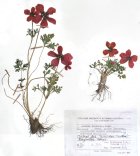 |
QUICK SEARCH
MO PROJECTS:
Africa
Asia/Pacific
Mesoamerica
North America
South America
General Taxonomy
Photo Essays
Training in Latin
America
MO RESEARCH:
Wm. L. Brown Center
Bryology
GIS
Graduate Studies
Research Experiences
for Undergraduates
Imaging Lab
Library
MBG Press
Publications
Climate Change
Catalog Fossil Plants
MO DATABASES:
W³MOST
Image Index
Rare Books
Angiosperm
Phylogeny
Res Botanica
All Databases
INFORMATION:
What's New?
People at MO
Visitor's Guide
Herbarium
Jobs & Fellowships
Symposium
Research Links
Site Map
Search
ORNAMENTAL PLANTS OF HORTICULTURE VALUESelection of perennials
Perhaps 120 species, cosmopolitan, mostly in the temperate regions of the Northern Hemisphere. Some species are well-known garden plants (Anemone sylvestris L.). A. bucharica (Regel) Finet et Gagnep.
Central Asia (Pamiro Alay). Rocky slopes in foothills. Rootstock tuberous. Flowering stem erect, pubescent in
upper part, to 10 cm at beginning of flowering, elongating
to 40 cm in fruit. Basal leaves dark green, 3-parted,
segments bipartite or trisected almost to base. Flowers 8
to 10 per plant, solitary or in pairs, with 2 or 3 bracts,
large, 4-6 cm diam., dark purple, red or orange-red. Stamens
dark violet. V - in nature February to June. Fl - April
(May in St. Petersburg cultivation). Fr - July (in St.
Petersburg). P - by seed sown immediately or by division.
Does well in dry, warm places. Suffers from excessive
moisture in autumn. Good for the rock garden. Z 5 (4).
New.
A. kuznetzowii Woronow ex Grossh. Caucasus (southern Transcaucasus). Among shrubs, in open woodlands. Rootstock tuberous. Stems 10-20 cm when flowering and 40 cm in fruiting period. Basal leaves long-petiolate, bipinnate, these segments trisected to mid-point. Bracts widely rhombic in outline, divided into three parts, these segments bipartite or narroowly trisect. Flowers solitary, rarely in pairs, 3.5 to 5.5 cm diam., bright red, with dark spots at base. V - early spring to mid autumn. Fl - April in the wild, end of May in Tbilisi. Fr - June. P - by seed and tuber division. Slightly shade tolerant. Requires well-drained soil. Very attractive. Good for group planting. Z 6 (5). New. A. tschernjaewii Regel Central Asia (Pamiro Alay). In sunny open forest, among shrubs, on steppe slopes in the mountains, up to 3,000 m. Rootstock tuberous. Stem elongating from 5 cm to 35 cm with fruits. Basal leaves 1 or 2, long-petiolate, 3-parted, segments shortly trilobate. Bracts 3-parted. Flowers solitary, 3.5-4.5 cm diam., light violet, pink with white tinge. Stamens violet, numerous. V - in nature February to June (April to July in St. Petersburg, where suffers from excessive moisture in autumn). Fl - April. Fr - June. P - by seed or division. Well suited for the rock garden. Z 5-4. New. The following Central Asian species of Anemone are also of garden interest. A. almaatensis Juz. Tien Shan. Tuberous roots. Stem ca. 25 cm. Leaves 3-parted. Flowers yellow. Z 4. New. A. baissunensis Juz. ex Scharipova Western Pamiro Alay. Similar to A. bucharica, differs in flower size and colour (smaller and yellow). Z 4. New. A. petiolulosa Juz. Central Asian mountains. Tuberous roots. Stem ca. 25 cm. Leaves 3-parted, deeply incised. Flowers 4 cm diam., yellow. Z 5 (4). New. |
|||
| SELECTION OF PERENNIALS |
© 1995-2025 Missouri Botanical Garden, All Rights Reserved
4344 Shaw Blvd.
St. Louis, MO 63110
(314) 577-5100
Technical Support
